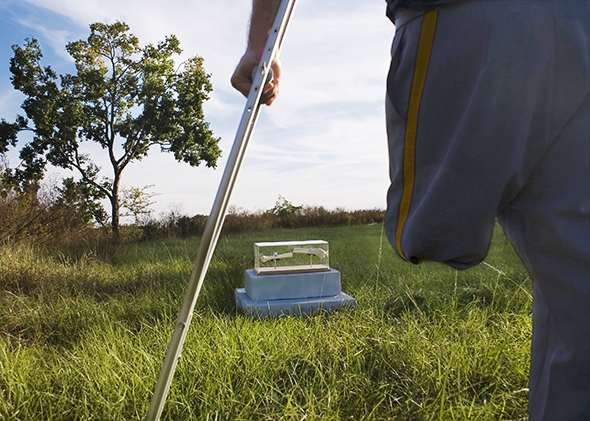
Can Custom Organs Help Fix the Healthcare System?
Professor Stephen Badylak speaks about regenerative technologies and their future potential.

Regenerative medicine can help military veterans who were injured during service.
Transplants can be costly and risky. Dr. Stephen F. Badylak, a professor in the Department of Surgery at the University of Pittsburgh, has a better idea. Using what's known as an extracellular matrix scaffold, he and his team at the McGowan Institute for Regenerative Medicine have been able to stimulate the body to re-grow its own cells. It's already been used successfully to regrow parts of fingers and muscles. In the future, it may be used to re-grow entire organs.
Dr. Badylak talked to us about the future of regenerative technologies and their future applications.
What is an extracellular matrix scaffold and how has it changed regenerative medicine?
An ECM scaffold is prepared from intact mammalian tissue. It can come from intestines, bladders and skins and it’s commercially available in a variety of other forms. The tissues are then removed of all cells and used to remodel injured tissues in patients. These scaffolds didn't exist 15 years ago, and they're an alternative to what has been traditionally viewed as the exclusive territory of synthetic scaffolds. Biological scaffolds have offered the field material that Mother Nature makes as opposed to material made by man and it's loaded with biologic signals that the body uses to control blood vessel formation and tissue growth. It has provided the field with a very friendly material that can change a patient’s response to an implant.
What are the benefits of recruiting a patient's own stem cells to rebuild tissues and organs instead of implanting stem cells?
The cell-based therapy involves a much more complicated approach because you have to isolate the cells, grow them outside the body and then deliver them back. It’s complicated from a company standpoint to manufacture those techniques. The regulations are also a lot stricter and it's a lot more costly. This approach recruits the cells to the sites. Even though it involves cells the caregiver doesn't deliver the cells. It's like implanting a honing device inside the body.
In a recent study, you were able to help veterans re-grow muscle tissue that had been injured during military service through this approach. How can regenerative medicine be of use to returning veterans who have suffered injuries?
The patients who had this muscle therapy had been walking around on canes and needing help with many of the activities of daily living like getting into a car or stepping off a curb. This therapy changed the quality of their lives. Veterans have certain problems like traumatic injuries, and so they benefit from these treatments. But they’re not directed solely at them. They’re for everybody.
What are some other uses in development?
It’s being investigated for treatment of stroke and for treatments of patients who've had heart attacks. It's also being developed for whole organs. It has extremely broad potential applications.
What work needs to be done before this sort of treatment can be implemented routinely and on a wide scale?
Millions of patients have already experienced this for routine uses like hernia repairs. But for the techniques like the muscle therapy, all that requires is time and education. It's just a matter of getting the types of studies done that the scientific and clinician community need to justify their use. And even though they might work now, they still need to be proven in controlled trials. That takes time. So it's not a matter of developing new materials, it's a matter of getting the studies done and educating the community about how they work.
What role does regenerative medicine have in the effort to increase human life expectancy?
The field is interested in quality of life, not necessarily the quantity of life. They probably go together—if you have a medical problem that is life threatening or decreases your quality of life, you can't live as long. But we're not interested in simply making people live longer so they can just suffer longer.
What are some of the long-term goals for regenerative medicine?
One of the most exciting ones is whole organ engineering—that is, growing hearts, livers and kidneys so people on a waiting list for a transplant can instead have a custom designed organ. That's a goal and I think it's reachable.
How far away are we from having this technology?
I think it's dangerous to predict timelines. Very rarely are those accurate. Usually they're too optimistic. I think it depends upon funding of research in the field and the quality of researchers that enter this field. You’re going to see a continuous rolling out of new applications constantly. Some will be minor. Others will be more dramatic.
How fast has this field developed during your career?
It's all relative, but in this particular approach to regenerative medicine the difference in the past decade has been incredible. It's been an almost astronomical growth. Other areas of regenerative medicine have been much slower, but there's been a dramatic shift in the understanding and acceptance of this approach over the past decade.
As life expectancy rises in the United States, how will your field be impacted?
As people age, they have more problems. So the potential patient population is expanding dramatically. People develop strokes. They need organs, new joints and knees. It's only increasing the demand for regenerative medicine.
Interview by Jordan G. Teicher.